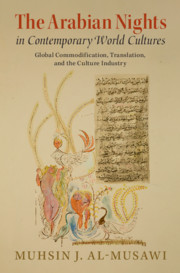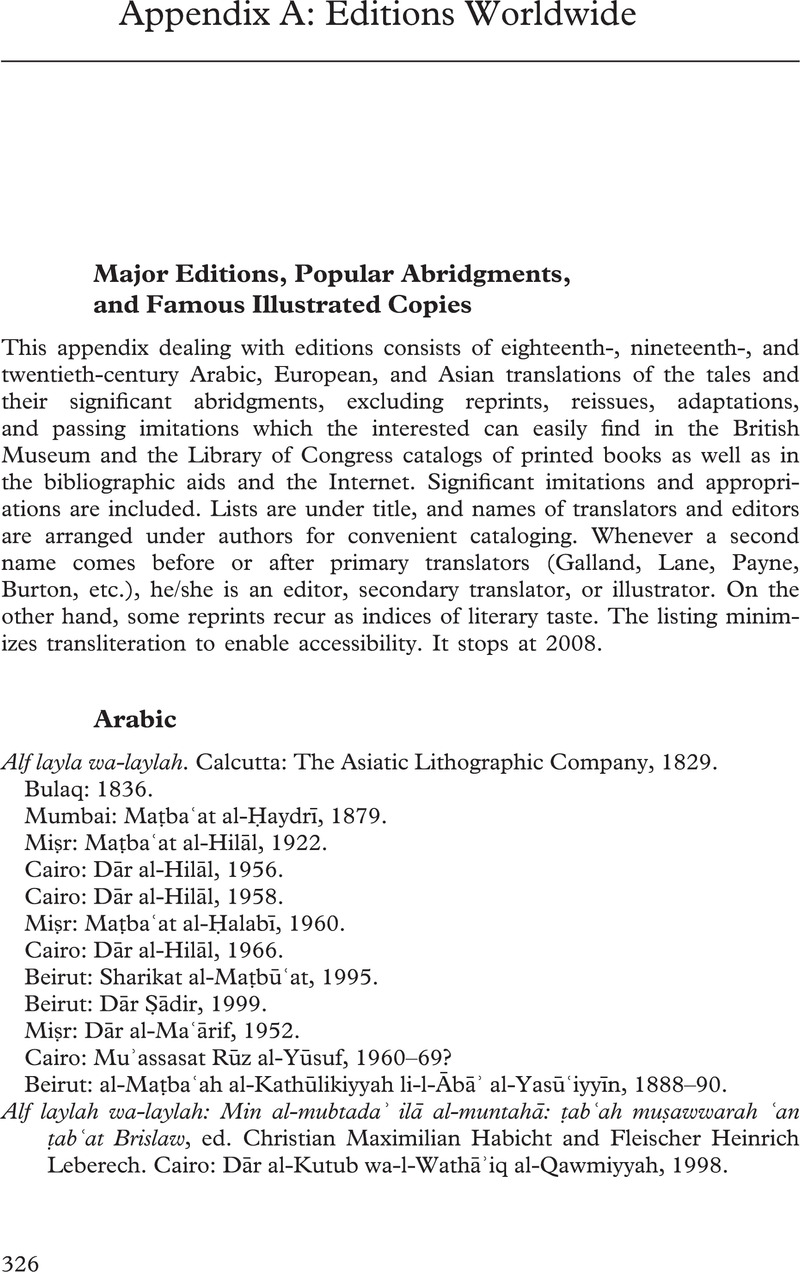 The Arabian Nights in Contemporary World Cultures
The Arabian Nights in Contemporary World Cultures Book contents
- The Arabian Nights in Contemporary World Cultures
- Frontispiece
- The Arabian Nights in Contemporary World Cultures
- Copyright page
- Dedication
- Contents
- Figures
- Acknowledgments
- Introduction
- 1 The Arabian Nights
- 2 The Scheherazade Factor
- 3 Engagements in Narrative
- 4 The “Hostile Dynasty”
- 5 The Archaeology of A Thousand and One Nights
- 6 Signatures and Affiliates
- 7 Decolonizing the Arabian Nights?
- 8 Invitation to Discourse
- Book part
- Select Bibliography
- Index
- References
Appendices
Published online by Cambridge University Press: 17 August 2021
- The Arabian Nights in Contemporary World Cultures
- Frontispiece
- The Arabian Nights in Contemporary World Cultures
- Copyright page
- Dedication
- Contents
- Figures
- Acknowledgments
- Introduction
- 1 The Arabian Nights
- 2 The Scheherazade Factor
- 3 Engagements in Narrative
- 4 The “Hostile Dynasty”
- 5 The Archaeology of A Thousand and One Nights
- 6 Signatures and Affiliates
- 7 Decolonizing the Arabian Nights?
- 8 Invitation to Discourse
- Book part
- Select Bibliography
- Index
- References
Summary

- Type
- Chapter
- Information
- The Arabian Nights in Contemporary World CulturesGlobal Commodification, Translation, and the Culture Industry, pp. 326 - 375Publisher: Cambridge University PressPrint publication year: 2021
References
Major Editions, Popular Abridgments, and Famous Illustrated Copies
This appendix dealing with editions consists of eighteenth-, nineteenth-, and twentieth-century Arabic, European, and Asian translations of the tales and their significant abridgments, excluding reprints, reissues, adaptations, and passing imitations which the interested can easily find in the British Museum and the Library of Congress catalogs of printed books as well as in the bibliographic aids and the Internet. Significant imitations and appropriations are included. Lists are under title, and names of translators and editors are arranged under authors for convenient cataloging. Whenever a second name comes before or after primary translators (Galland, Lane, Payne, Burton, etc.), he/she is an editor, secondary translator, or illustrator. On the other hand, some reprints recur as indices of literary taste. The listing minimizes transliteration to enable accessibility. It stops at 2008.
Arabic
Chinese
See Ouyang, Wen-chin, “The Arabian Nights in Chinese and English Translations: Differing Patterns of Cultural Encounter and World Literature,” in World Literature in Motion: Institution, Recognition, Location, ed. Shi, Flair Donglai and Tan, Gareth Guangmin (Stuttgart: ibidem-Verlag, 2020), 435–474.
Croatian
Czech
Danish
Dutch (Earlier Editions Mentioned in the Text)
English
Here is not the place to dwell on the first appearance in English of Galland’s Nights (see W. H. Mcburney, Check List, 10–11). One may notice in passing, however, that Bell’s 1708 twelve-volume edition (Term Catalogues, III, 592) is probably a reissue of the 1704 copy. An advertisement for a newly published three-volume copy appeared in the Diverting Works of the Countess D’Anois (1707). A third edition in seven volumes was on sale in 1711 (Term Catalogues, III, 677–78). The following editions, mentioned in the British Museum and the Bodleian Library catalogs, will give a bibliographic indication of the vogue of the Nights in the eighteenth century: the fourth edition (in 12 vols., Andrew Bell, 1713–15); the fifth (bound in 4 vols., Andrew Bell, 1717–22); the sixth (12 vols., Osborne & Longman, 1725); the seventh (6 vols., bound in 4, Dublin: Powell & Risk, 1728); the eighth (8 vols., Longman, 1736); the tenth (4 vols., Dublin: Whitestone, 1776); the fourteenth (4 vols., London: Longman, 1778); the eighteenth (4 vols., Montrose: Buchanan, 1798); Harrison’s (The Novelist’s Magazine) with plates by E. F. Burney in 1785. For serialized issues, see Robert D. Mayo; and for cheap prints, see Chauvin, IV, and MLA bibliographic listings. Excepting some editions of individual tales, most of the items below are based on the major English translations that are marked with asterisks. Arrangement is mainly by author (redactor, translator, or editor) or by title in cases of anonymous editions and translations. Chronology is preserved whenever anonymous works bearing the same title are cited.
French
Reprints of Galland’s translation are mentioned below to show the popularity of this translation.
German (Earlier Editions Mentioned in the Text)
Greek
For a survey, see Papachristophorou, Marilena. “The Arabian Nights in Greece: A Comparative Survey of Greek Oral Tradition.” Fabula 45, 3–4, 2004. 311–329; revised version in The Arabian Nights in Transnational Perspective. ed. by Ulrich Marzolph. Detroit: Wayne State Univ. Press 2007, pp. 291–311.
Hebrew
Italian
Japanese
Korean
Persian
Romanian
Russian
Spanish
Swedish
Turkish
See Birkalan(-Gedik), Hande E. “The Thousand and One Nights in Turkish: Translations, Adaptations, and Related Issues.” Fabula 45, 3–4: 2004. 189–206; revised version in The Arabian Nights in Transnational Perspective. ed. by Ulrich Marzolph. Detroit: Wayne State Univ. Press 2007, pp. 201–220.
